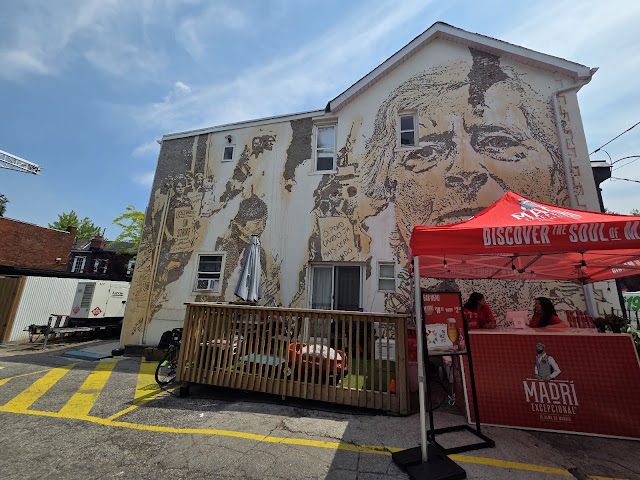I'm linking up at Monday Mural
June 2025 - Toronto ON
I found a Bordalo II here in Toronto in Little Portugal on the weekend!! Titled Eastern Cottontail.
Click on Bordalo II in the tags/labels below this post to see more Bordalo in Portugal and the States,
The mastermind behind the piece is none other than Lisbon-born artist Artur Bordalo, who uses the name Bordalo II in tribute to his grandfather.
The BIA Little Portugal with the official support of Portuguese Embassy, partnering with Café Pessoa – Cultural Strategies, based in Lisbon, invited the artist Bordalo II to take over the Dundas’ West corner. / Objeto de arte do artista Bordalo II no Little Portugal, na Dundas St W (sul) a oeste da Lisgar.
Bordalo's "Big Trash Animals" series represents animals — which are built almost exclusively with garbage — on a large scale, inviting us to take a hard look at our own consumerist habits.
The series now consists of nearly 200 pieces around the globe and usually depicts native, endangered, or even extinct species.
The production of each piece involves collecting materials, cutting and adapting the collected material, as well as assembling, fixing, and painting the garbage.
A few others found along Dundas. If you click on the label/tag "Dundas West Open AirMuseum" below this post you will find other murals along this street from previous years.
Called Scratching the Surface, is etched on the side of 1628 Dundas St. W. and comes from another Portuguese artist Vhils (AKA Alexandre Farto).
Vhils, whose work is found around the world, is known for his bas-relief carving technique — carving, cutting, drilling and at times blasting with explosives in a "creative destruction process."
There is a sign that says “In 1975, night cleaners who worked in the Queen’s Park building organized for better pay. These women sparked a movement known as Cleaner’s Action."
“Part of my ongoing Scratching the Surface project, this new mural celebrates and honours the Portuguese immigrant women who toiled as janitorial workers in the high-rise office towers in downtown Toronto in the 1970’s. Portuguese “cleaning ladies” have been a constant presence in the lives of countless Portuguese-Canadians as mothers, wives, breadwinners, community members, and activists, and are an example of strength, resilience, perseverance and courage for us all. "
Influenced by sixties-era progressivism, teacher Sidney Pratt left Indianapolis for Brazil, where she applied the teachings of Paolo Freire, was a literacy activist, and participated in organizations of the international Christian left. During her Toronto years (1972-1987), she worked with the Free Interpreter Service at St Christopher (settlement) House, where she also initiated Cleaners’ Action among other programs. As an Ontario government civil servant, she initiated English in the Workplace classes and literacy classes for immigrants. She lives in Brazil. Portuguese-born Marcie Ponte (Santa Maria) first became involved in immigrant women’s activism as a college student, initially with St. Stephen’s Community House. She was a union organizer for the International Lady Garment Workers Union and served on the Labour Council. Since 1999, she has been Executive Director of the Working Women Community Centre, a woman-focused settlement agency for newcomers.
So I trotted out, found this beautiful little bird person and added the piece on the left and the stars to create a story.. Something about sharing magic. Stories and wisdom. Art. All the good things in the world. ✨









.jpg)
I love both the first and last mural.
ReplyDelete...the rabbit has quite a message.
ReplyDeleteVhils and Bordalo are two of the greatest Portuguese mural artists! I like the last one too. We have a Whils here in Perth, but no Bordalo. Thanks for participating in Monday Murals Jackie.
ReplyDeleteI was so excited when I suddenly saw the mural and realized it was a Bordalo. And the Vhils mural description was waiting patiently in my drafts folder until I found his mural. It was surprised me on Saturday.
Delete